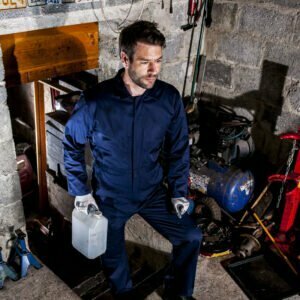EN 510
Anti-entanglement protective clothing
UNI EN 510:1994 outlines the properties of protective clothing designed to minimise the risk of entanglement or entrapment by moving parts when the operator is working near or on hazardous moving machinery or equipment. It does not apply to protective clothing intended to safeguard against injuries caused by specific machine components for which dedicated standards exist, such as protective clothing for chainsaw users.
Protection against entanglement
Entanglement is a hazard associated with mechanical risks. When using machinery and work equipment, the operator is exposed to various potential hazards:

- Crushing, a part of the body can be crushed between two moving mechanical elements;
- Shearing, machinery or equipment operation can lead to the removal of a body part.
- Cutting or severing, this type of injury occurs in the presence of sharp mechanical elements;
- Perforation or puncture, sharp elements can penetrate a part of the body.;
- Cutting or severing, this type of injury occurs in the presence of sharp mechanical elements;
- Projection of fluids, solid bodies, or machine parts: this includes splashes or splinters that can strike the operator;
- Impact, a blow can result from moving mechanical parts.
- Slipping, tripping or falling: common injuries when working at height;
- Entanglement, dragging or entrapment.
The risk of entanglement is addressed by the UNI EN 510:1994 standard and is a risk that should not be underestimated. Body parts like hands and hair, as well as items such as laces, sleeves, ties, scarves, bracelets, watches, necklaces, or other accessories worn by the operator, can get caught on the moving machine and be dragged along with the machine’s movement.
Scope of Application
It is crucial to use anti-entanglement clothing to prevent entanglement with machinery such as grinding wheels, rotating cylinders, chains, and drive belts. This type of clothing must be worn by various types of workers, including:
- Lathe operators
- Finishing workers
- Sandblasting workers
- Blanking workers
- Milling workers
- Plasma metal cutters
- Drawing workers
- Users of paper converting machines
- Mechanics
- Operators in manufacturing industries
- Industrial plant maintainers
General Requirements for Anti-Entanglement Protective Clothing
Anti-entanglement work clothing, produced in accordance with the UNI EN 510:1994 standard, must possess specific features to ensure this type of protection. Specifically::
- Pockets should be located on the inside of the garment and must be secured with Velcro closures;
- Buttons, zippers, and buckles must be resistant to rust.
- Fasteners should be covered and easily accessible (with Velcro) for quick removal in emergencies;
- All seams must be reinforced on the inside;
- Zipper openings should be concealed by flaps secured with Velcro.;
- Pockets must be fastened with Velcro;
- Any folds created must be oriented inwards;
- The cuffs of the sleeves and trousers should be adjustable and snugly fit the body, usually with elastic bands;
- An internal adjustment system (typically elasticated) should be present at the waist.
 |
 |
| NARROW SLEEVES AND ADHERENT | FASTENERS WITH VELCRO |
For anti-entanglement clothing options, visit our website to explore the catalogue of anti-entanglement workwear catalogue.




